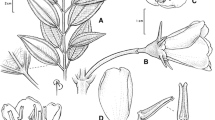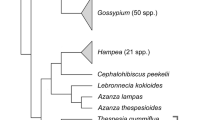Abstract
As a result of a recent alpha-taxonomic study of the genusMagnolia s. str. in Mexico and Central America, four new species and four new subspecies ofMagnolia sect.Theorhodon are proposed, includingM. iltisiana, M. panamensis, M. tamaulipana, M. sororum subsp.lutea, andM. pacifica, consisting of three subspecies:pacifica, pugana, andtarahumara. Additionally, a new combination,M. guatemalensis subsp.hondurensis, is made, and a new section,M. sect.Splendentes, is erected for the Caribbean species. The results have implications for understandingMagnolia biogeography, andM. tamaulipana has potential for horticulture in temperate zones. Keys to genera, sections, and species, and maps of species distributions are presented.Magnolia grandiflora L. andM. schiedeana Schltdl. are lectotypified.
Resumen
Como resultado de un estudio alfa-taxonómico reciente del géneroMagnolia s.str. en México y Centro América, se proponen cuatro especies nuevas y cuatro subespecies nuevas deMagnolia sect.Theorhodon, incluyendoM. iltisiana, M. panamensis, M. tamaulipana, M. sororum subsp.lutea y.M. pacifica, la última consiste de tres subespecies:pacifica, pugana ytarahumara. Adicionalmente, se hace la combinaciónM. guatemalensis subsp.hondurensis y se erigeM. sect.Splendentes para las especies del Caribe. Los hallazgos tienen implicaciones en el entendimiento de la biogeografia deMagnolia y.M. tamaulipana tiene potencial en la horticultura de zonas templadas. Se presentan claves para géneros, secciones y especies, y mapas de distribución para las especies.Magnolia grandiflora L. yM. schiedeana Schltdl. son lectotipificadas.
Similar content being viewed by others
Literature Cited
Catesby, M. 1738. Natural history of Carolina, Florida and the Bahama Islands. Vol. 2. London.
Dandy, J. E. 1978. A revised survey of the genusMagnolia together withMangletia andMichelia. Pages 27–37.In: N. G. Treseder, itor. Magnolias. Faber & Faber, London.
Felger, R. S. 1971. The distribution ofMagnolia in northwestern Mexico. J. Arizona Acad. Sci. 6: 251–253.
Figlar, R. B. 1993. Stone magnolias. Arnoldia (Jamaica Plain) 53(2): 2–9.
Golenberg, E. M., D. Giannasi, M. T. Clegg, C. J. Smiley, M. Dorbin, D. Henderson &G. Zurawski. 1990. Chloroplast DNA sequence from a MioceneMagnolia species. Nature 344(6267): 656–658.
Gould, S. J. 1992. Magnolias from Moscow. Nat. Hist. 9: 10–18.
Guzmán-M., R. &H. H. Iltis. 1991. Biosphere reserve established in Mexico to protect rare maize relative. Diversity 7: 82–84.
Hernández, F. 1651. Nova Plantarum Animalarum Historia Mexicana, Rome. [1959. Historia Natural de Nueva España 1: 368. (Spanish transl. ed.) Univ. Nacional de Mexico, Mexico City, D.F.]
Hernández-C., M. E. 1980. Magnoliaceae. Flora de Veracruz 14: 1–14.
Hernández-X., E., H. Crum, W. B. Fox &A. J. Sharp. 1951. A unique vegetational area in Tamaulipas. Bull. Torrey. Bot. Club 78: 458–463.
Howard, R. A. 1948. The morphology and systematics of the West Indian Magnoliaceae. Bull. Torrey Bot. Club 75: 335–357.
Johnson, D. L. 1989. Nomenclatural changes inMagnolia. Baileya 23(1): 55–56.
Law, Yuh-Wu. 1984. A preliminary study of the taxonomy of the family Magnoliaceae. Acta Phytotax. Sin. 22(2): 89–109.
Little, E. L., Jr. 1979. Checklist of United States trees. Agriculture Handbook No. 541. Forest Service, U.S.D.A., Washington, D.C.
Lozano-C., G. 1983. 1. Magnoliaceae. Pages 1–120.In: P. Pinto, editor. Flora de Colombia, Universidad Nacional de Colombia, Bogota, Colombia.
Miller, P. 1757. The Gardener’s Dictionary, ed. 7, 2. Published by the author, London.
Noteboom, H. P. 1985. Notes on Magnoliaceae. Blumea 31: 65–121.
Rockwell, H. C. 1966: The genusMagnolia in the United States. M. S. thesis. University of West Virginia, Morgantown, West Virginia.
Standley, P. C. & J. Steyermark. 1946. Magnoliaceae.In: Flora of Guatemala. Fieldiana, Bot. 24: 266–269.
Tiffney, B. H. 1977. Fruits and seeds of the Brandon Lignite: Magnoliaceae. J. Linn. Soc., Bot. 75: 299–323.
Tobe, J. D. 1993. A molecular systematic study of eastern North American species ofMagnolia L. Ph.D. dissertation. Clemson University, Clemson, South Carolina.
—. 1993. Inheritance of chloroplast DNA in Magnolia. J. Magnolia Soc. 28(2): 25–31.
Treseder, N. G. 1978. Magnolias. Faber & Faber, London.
Trew, C. J. 1752. Plantae selectae.Dec. 1: 8.
Vázquez-G., J. A. 1990. Taxonomy of the genusMagnolia in Mexico and Central America. M.S. thesis. University of Wisconsin, Madison, Wisconsin.
Author information
Authors and Affiliations
Rights and permissions
About this article
Cite this article
Vázquez-G., J.A. Magnolia (Magnoliaceae) in Mexico and Central America: a synopsis. Brittonia 46, 1–23 (1994). https://doi.org/10.2307/2807454
Issue Date:
DOI: https://doi.org/10.2307/2807454




